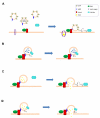Class II phosphoinositide 3-kinase C2alpha: what we learned so far
- PMID: 21968800
- PMCID: PMC3180093
Class II phosphoinositide 3-kinase C2alpha: what we learned so far
Abstract
More than fifteen years after the first identification of a class II isoform of phosphoinositide 3-kinase (PI3K) in Drosophila melanoǵaster this subfamily remains the most enigmatic among all PI3Ks. What are the functions of these enzymes? What are their mechanisms of activation? Which downstream effectors are specifically regulated by these isoforms? Are class I and class II PI3Ks redundant or do they control different intracellular processes? And, more important, do class II PI3Ks have a role in human diseases? The recent increased interest on class II PI3Ks has started providing some answers to these questions but still a lot needs to be done to completely uncover the contribution of these enzymes to physiological processes and possibly to pathological conditions. Here we will summarise the recent findings on the alpha isoform of mammalian class II PI3Ks (PI3K-C2α ) and we will discuss the potential involvement of this enzyme in human diseases.
Figures




Similar articles
-
Regulation and cellular functions of class II phosphoinositide 3-kinases.Biochem J. 2012 May 1;443(3):587-601. doi: 10.1042/BJ20120008. Biochem J. 2012. PMID: 22507127 Review.
-
Suppression of the alpha-isoform of class II phosphoinositide 3-kinase gene expression leads to apoptotic cell death.Biochem Biophys Res Commun. 2005 Apr 1;329(1):6-10. doi: 10.1016/j.bbrc.2005.01.091. Biochem Biophys Res Commun. 2005. PMID: 15721265
-
The α-isoform of class II phosphoinositide 3-kinase is necessary for the activation of ERK but not Akt/PKB.Mol Cell Biochem. 2011 Jan;346(1-2):95-101. doi: 10.1007/s11010-010-0596-1. Epub 2010 Oct 6. Mol Cell Biochem. 2011. PMID: 20924651
-
An Overview of Class II Phosphoinositide 3-Kinases.Curr Top Microbiol Immunol. 2022;436:51-68. doi: 10.1007/978-3-031-06566-8_2. Curr Top Microbiol Immunol. 2022. PMID: 36243839
-
Class II PI3K Functions in Cell Biology and Disease.Trends Cell Biol. 2019 Apr;29(4):339-359. doi: 10.1016/j.tcb.2019.01.001. Epub 2019 Jan 25. Trends Cell Biol. 2019. PMID: 30691999 Review.
Cited by
-
Essential role of class II phosphatidylinositol-3-kinase-C2α in sphingosine 1-phosphate receptor-1-mediated signaling and migration in endothelial cells.J Biol Chem. 2013 Jan 25;288(4):2325-39. doi: 10.1074/jbc.M112.409656. Epub 2012 Nov 28. J Biol Chem. 2013. PMID: 23192342 Free PMC article.
-
Phosphatidylinositol 3-Kinase Couples Localised Calcium Influx to Activation of Akt in Central Nerve Terminals.Neurochem Res. 2016 Mar;41(3):534-43. doi: 10.1007/s11064-015-1663-5. Epub 2015 Jul 22. Neurochem Res. 2016. PMID: 26198194 Free PMC article.
-
Development of synchronous VHL syndrome tumors reveals contingencies and constraints to tumor evolution.Genome Biol. 2014 Aug 27;15(8):433. doi: 10.1186/s13059-014-0433-z. Genome Biol. 2014. PMID: 25159823 Free PMC article.
-
PI3K class II α regulates δ-opioid receptor export from the trans-Golgi network.Mol Biol Cell. 2017 Aug 1;28(16):2202-2219. doi: 10.1091/mbc.E17-01-0030. Epub 2017 May 31. Mol Biol Cell. 2017. PMID: 28566554 Free PMC article.
-
Phosphoinositide 3-Kinases as Potential Targets for Thrombosis Prevention.Int J Mol Sci. 2022 Apr 27;23(9):4840. doi: 10.3390/ijms23094840. Int J Mol Sci. 2022. PMID: 35563228 Free PMC article. Review.
References
-
- Cantley LC. The phosphoinositide 3-kinasepathway. Science. 2002;296:1655–7. - PubMed
-
- Vanhaesebroeck B, Guillermet-Guibert J, Grau-pera M, Bilanges B. The emerging mechanisms of isoform-specific PI3K signalling. Nat Rev Mol Cell Biol. 2010;11:329–41. - PubMed
-
- Engelman JA, Luo J, Cantley LC. The evolution of phosphatidylinositol 3-kinases as regulators of growth and metabolism. Nat Rev Gen. 2006;7:606–19. - PubMed
-
- Falasca M. PI3K/Akt signalling pathway specific inhibitors: a novel strategy to sensitize cancer cells to anti-cancer drugs. Curr Pharm Des. 2010;16:1410–6. - PubMed
LinkOut - more resources
Full Text Sources
